
2018下半年小学英语教师资格证面试试题(精选)第三批
时间:2019-10-12 17:36 来源:未知
- 【考试公告】2020年上半年教师资格证考试公告
- 【报名入口】2020年上半年教师资格证报名入口
- 【备考资料】教师资格证笔试资料免费领
- 【公益讲座】教师资格证笔试免费公开课
- 【辅导课程】教师资格证笔试课程
- 【每日一练】每日打卡
小学英语 语音
一、考题回顾
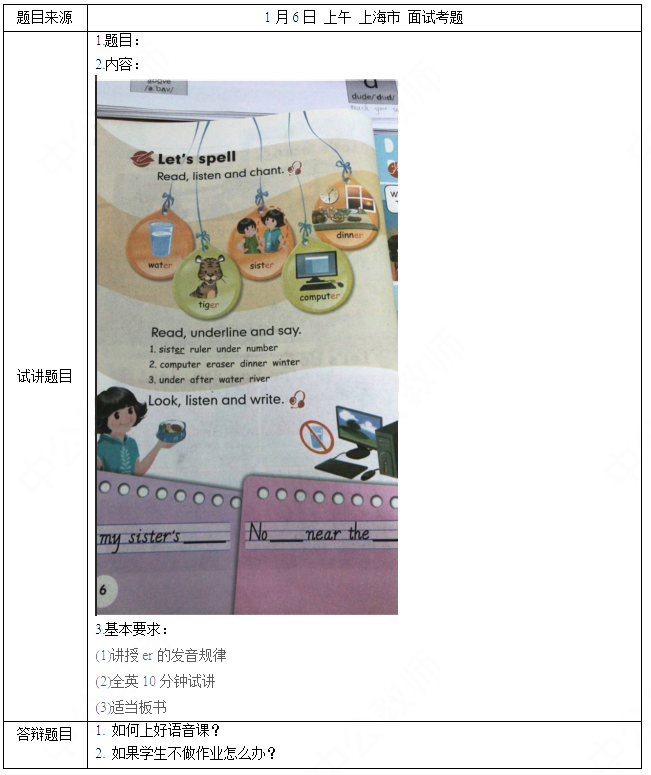
二、考题解析
【教案】
Teaching aims:
Knowledge aim:
Students will master the meaning and pronunciation of the word.
Ability aim:
Students will know how to pronounce “-er” in words.
Emotional aim:
Students will be interested in learning English.
Key and difficult point:
Key Point:
Students will master the meaning and pronunciation of the word.
Students will know how to pronounce “-er” in words.
Difficult Point:
Students will be interested in learning English.
Teaching procedure:
Step 1: Warming-up
1. Greetings.
2. Sing a song Finger Family.
Daddy finger, daddy finger, where are you?
Here I am, here I am, how do you do?
Mommy finger, mommy finger, where are you?
Here I am, here I am, how do you do?
Ask them if they know the name of the song. Then may guess it is Finger Family. Then tell them that we are going to learn some pronunciation in “finger”.
Step 2: Presentation
1. Use some riddles to introduce the words. For example, “I will drink it every day. What is it? Yes, it’s water.” Then draw the according pictures(introduce “sister” by explaining its meaning). And write the words at last.
2. Ask the students to read the words after the teacher for twice. Then play high and low voice. If the teacher speak one word loudly, the students should speak it lowly, and vice versa.
3. Ask students to find similarities among the words. They may say that they all contain “-er” at the end of the words. Then introduce the rules of the pronunciation.
4. Ask students if they know other words containing “-er”. They may say “winter”, “river” or others.
Step 3: Practice
1. Finish Read, underline, and say in the textbook. Check answers, and ask students to read after the teacher.
2. Finish Look, listen and write in the textbook. Then invite students share their answers on the blackboard. Give encouragement.
Step4: Production
1. Ask students to make up a chant using the words we learned. For example:
Water, water, tiger likes water.
Sister, sister, sister likes computer.
Dinner, dinner, let’s have dinner.
Step5: Summary and Homework
Summary: ask a student to conclude the content of the lesson and summarize with the whole class.
Homework: chant for the students’ parents.
Blackboard design:
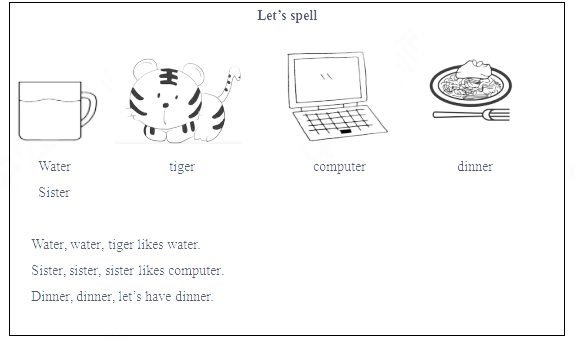
【答辩题目解析】
1. What is a good pronunciation lesson?
【参考答案】
A good pronunciation lesson should make students master the rules of the pronunciation, and they can apply the rules when encounter the syllables in the future. So in my lesson, I firstly let the students find similarities among the words, then I conclude the rules. After that, I ask them if they know other words that share the same pronunciations. Later, few exercises are conducted so that they can consolidate the knowledge. Thus, I believe I have given a good pronunciation lesson.
【答辩题目解析】
2. What will you do if one of the students in your class doesn’t do homework?
【参考答案】
Firstly, I will ask him or her to finish the homework as soon as possible. Secondly, I will try to talk with the student patiently to figure out the reason. If the student say that they have too much homework, then I will try to reduce the homework amount afterward. If the student think homework is not important, I will tell that homework is a good way to absorb the knowledge learned today, otherwise they will forget it quickly. Lastly, I will talk to his or her parents to let them also focus on the problem and address it together with us.
2018年下半年教师资格面试-英语学科-试讲-考题解析
小学英语 听说
一、考题回顾
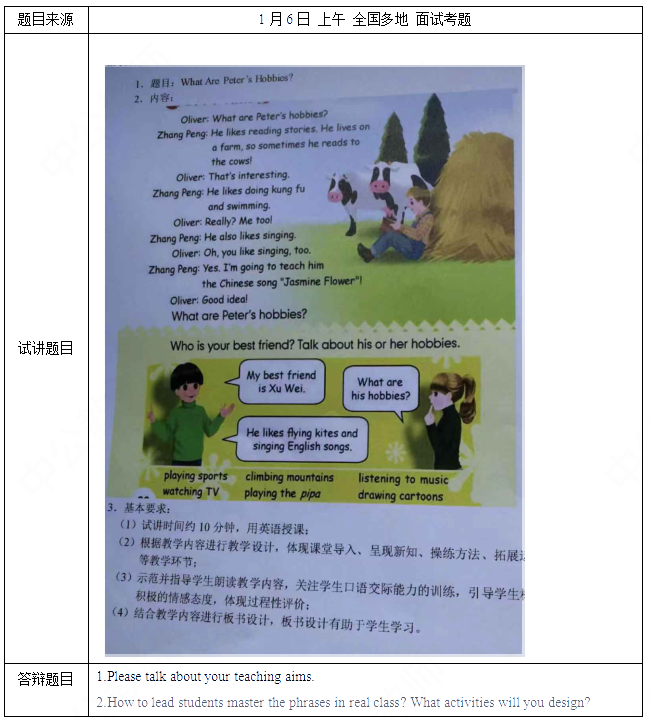
二、考题解析
【教案】
Teaching aims:
Knowledge aim:
Students will master some phrases about hobbies and the sentence structure about how to talk about hobbies
Ability aim:
Students will improve their speaking ability in talking about hobbies.
Emotional aim:
Students will be more confident in speaking English.
Students will arouse their interest in learning oral English.
Key and difficult point:
Key Point: How to talk about hobbies.
Difficult Point:
Students will be more confident in speaking English.
Students will arouse their interest in learning oral English.
Teaching procedure:
Step 1: Warming-up
1. Greeting.
2. Chant: Dog, dog, what can you do?
I can run after you.
Panda, panda, what can you do?
I can eat so much bamboo.
Mouse, mouse, what can you do?
I can hide in the shoe.
Mike, Mike, what can you do?
I can draw animals in the zoo!
Step 2: Presentation
1. Read the dialogue by the teacher, and ask what the dialogue is about. (It’s about Peter’s hobbies)
2. Let the students find what Peter’s hobbies are. And tell them we can use what’s ..’s hobbies? to ask others’ hobby.
He likes reading stories, doing Kung fu and swimming and he also like singing.
Meanwhile I will use pictures and actions to help them understand these phrases and add -s after like when we meet he/she/it and v-ing follows the verb like.
Step 3: Practice
1.Listen to the tape and try to follow it. Then give them 5 minutes to role play the conversation in pairs.
2.Invite volunteer to answer my question: who is your best friend? What are his/her hobbies.
Step 4: Production
Work in group of four to do a survey ask group members two questions: who is your best friend? What are his/her hobbies. Fill in the chart and then do a report in 7mins.
Step5: Summary and Homework
Summary: make a brief summary of what we have learned today.
Homework: Ask their parents what their hobbies are and draw their hobbies down.
Blackboard design:
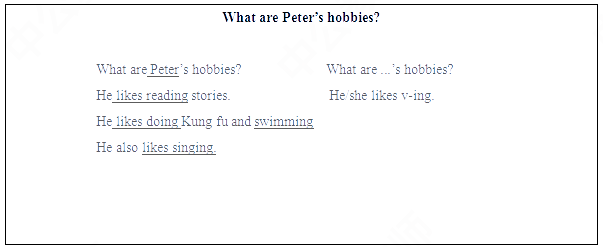
【答辩题目解析】
1.Please talk about your teaching aims.
【参考答案】
Knowledge aim:
Students will master some phrases about hobbies and the sentence structure about how to talk about hobbies
Ability aim:
Students will improve their speaking ability in talking about hobbies.
Emotional aim:
Students will be more confident in speaking English.
Students will arouse their interest in learning oral English.
2.How to lead students master the phrases in real class? What activities will you design?
【参考答案】
Due to the limited time I design few activities. In real class. I will give students more example to understand the function of the sentence structure. At the same time, more practice will be used such as the mechanical drilling: filling in the blanks with the correct form of verbs and make up sentences with given words. And meaningful drilling describe the pictures and so on.
2018年下半年教师资格面试-英语学科-试讲-考题解析
小学英语 语音
一、考题回顾
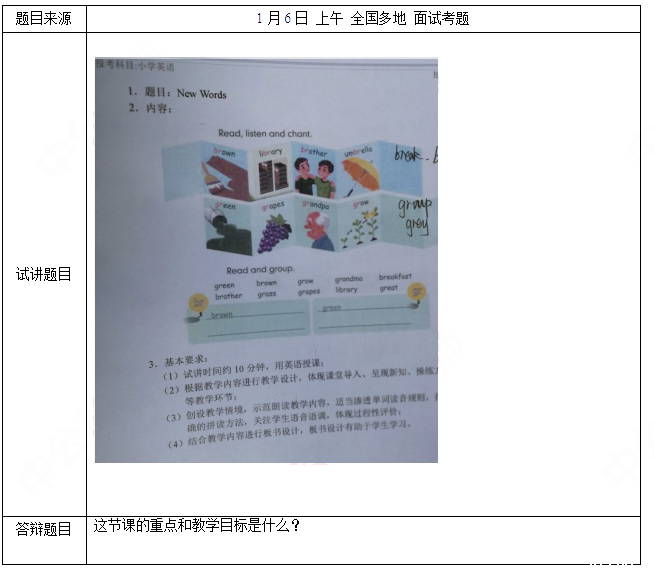
二、考题解析
【教案】
Teaching aims:
Knowledge aim:
Students will master the pronunciation of letter group br and gr
Ability aim:
Students will improve their speaking ability .
Emotional aim:
Students will be more confident in English learning.
Key and difficult point:
Key Point and difficult Point: the pronunciation of these two letter groups and can discriminate them in speaking and listening.
Teaching procedure:
Step 1: Warming-up
1. Greeting.
2. Chant:
Red red red touch your head,
Blue blue blue tie your shoe,
Brown brown brown touch the ground,
White white white take a bite,
Black black black touch your back,
Purple purple purple draw a circle,
Pink pink pink give a wink,
Gray gray gray shout hurray!
Step 2: Presentation
1. Present the words by showing pictures. Then let them find the pronunciation of br- and gr-.
2. Spell the words, such as /gr//ei//p/-/greip/.
Step 3: Practice
1. Flash card. I show the pictures and students say the words.
2.Let students read and group.
Step 4: Production
Look at the pictures and complete the sentences with the words with br- and gr-. such as There is a boy with a green umbrella.
Step5: Summary and Homework
Summary: make a brief summary of what we have learned today.
Homework: Summarize the words we learnt with br- and gr-.
Blackboard design:

【答辩题目解析】
1.Please talk about your key and difficult points.
【参考答案】
Key Point and difficult Point: the pronunciation of these two letter groups and can discriminate them in speaking and listening. In this class, I adopt three steps to achieve them. First let them experience the pronunciation by reading words the summarize the rules. Then use two activities to practice them. At last, the production step is used to check whether they master the new knowledge.
2. What are your teaching aims?
【参考答案】
Knowledge aim:
Students will master the pronunciation of letter group br and gr
Ability aim:
Students will improve their speaking ability .
Emotional aim:
Students will be more confident in English learning.
(责任编辑:admin)















